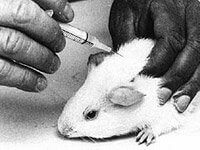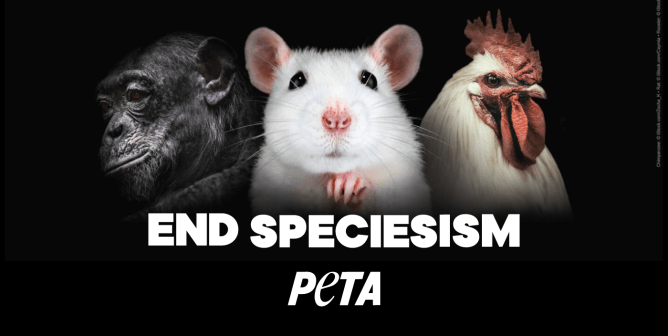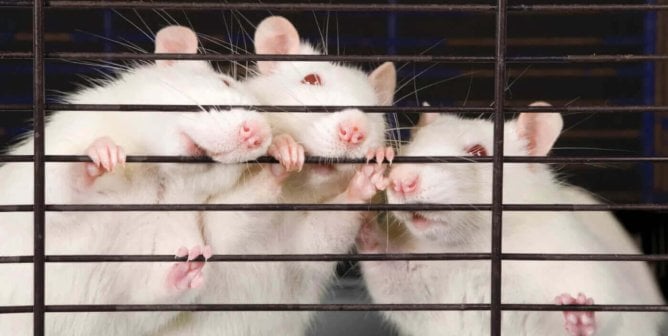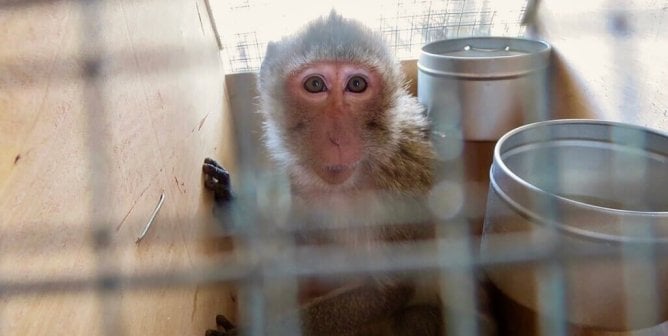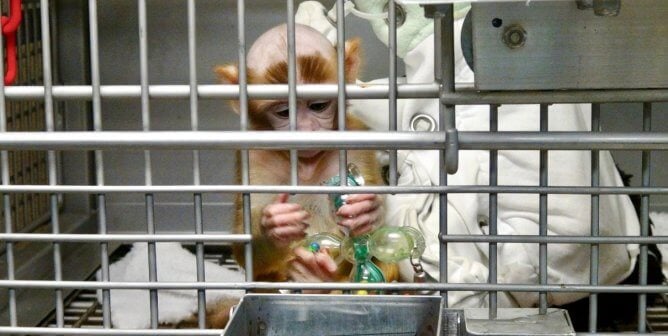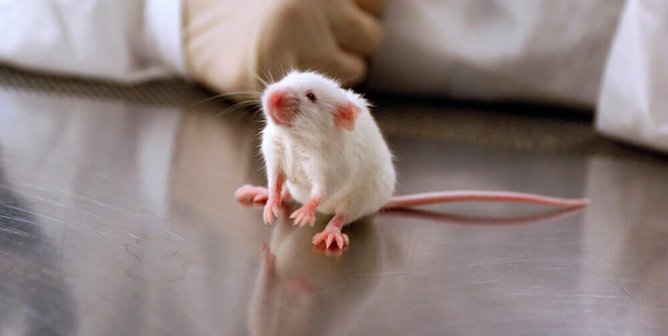Questions and Answers
What is the HPV program?
In 1998, the Environmental Protection Agency’s (EPA) High Production Volume (HPV) Chemicals Challenge Program “challenged” the industry to make baseline health and environmental effects data available to the public for nearly 2,800 HPV chemicals produced or imported into the U.S. in quantities of 1 million or more pounds per year. As originally envisioned, this unprecedented five-year program would have meant that up to seven different animal tests could have been required for each chemical, killing more than 1 million mice, rats, rabbits, and guinea pigs and countless birds and fish. Since negotiating an agreement in 2000 between the U.S. animal protection community, the White House, and the EPA to reduce the numbers of animals used, PETA has commented on every test plan that proposed animal use. Although most of the program is coming to a close, PETA continues to monitor the remaining untested chemicals and test plans.
Who is responsible for the HPV program?
The HPV chemical-testing program was initiated in response to intense government lobbying by the advocacy group Environmental Defense Fund (EDF).
The program was the result of closed-door meetings in 1998 among EDF, the Chemical Manufacturers Association, and the Clinton-Gore administration. Even though the program started in November 1998, the EPA only gave public notice of the HPV program two years later—in December 2000. As a result, the program bypassed normal governmental procedures of scientific review and public comment.
What tests are being used in the HPV program?
Under the threat of having mandatory testing imposed on them by future EPA regulation, 469 companies agreed to sponsor 2,155 chemicals in the HPV program. Faulty tests using animals often work in favor of the chemical industry because they are frequently inconclusive. Animal tests can actually clear chemicals already known to be hazardous or delay the regulation or restriction of those chemicals. Furthermore, recent articles quote industry representatives as supporting the HPV program in order to avoid a Congressional examination of the ineffectiveness of the Toxic Substances Control Act, which the EPA has not used even once in the past decade to ban a dangerous industrial chemical.
Why is the chemical industry participating?
The HPV program called on the chemical industry to collect toxicity information for each HPV chemical using an arbitrary checklist of animal-poisoning tests. These tests sometimes involve forcing chemicals down animals’ throats or forcing them to inhale chemicals. Click here for more information about specific test methods.
Are the results of animal tests relevant to humans?
There is much scientific evidence documenting the failure of animal-based toxicity tests to accurately predict human reactions to chemicals. Such failures are not surprising, given the many differences that exist between species in terms of their anatomy, physiology, biochemistry, and metabolism. These variables make it impossible to accurately extrapolate test results from one species to another. Click here for more information about scientific problems with animal tests.
Are there any non-animal methods that could replace animal tests in the HPV program?
There have been many advances in non-animal testing in recent years, and as a result, much of the testing required by the HPV program potentially could be done without poisoning animals. One such method, which uses cell lines to test for a chemical’s ability to damage chromosomes, was incorporated into the program—but only after a huge effort on PETA’s part. There are currently several additional non-animal tests, including a cell-based test to replace the crude and cruel lethal-dose tests that are nearing the final stage of completion. It is also important to note that human experience and occupational exposure data are ignored in the HPV program even though they could provide a far more accurate picture of a chemical’s true hazard. Click here for more information about non-animal methods.
Is it true that many HPV chemicals are missing a lot of important information?
Reports published by EDF, the American Chemistry Council (ACC), and the EPA greatly underestimate what is known about HPV chemicals. As a result, the conclusions reached in these reports are seriously flawed and misleading. For example, EDF’s report “Toxic Ignorance” would have one believe that a lack of animal toxicity testing for wood shavings is a threat to public health. Similarly, the EPA study claimed that vinyl chloride has never been studied for its long-term toxic effects, despite other government documents showing that vinyl chloride has been the focus of hundreds of human population and animal studies for more than 50 years.
Research conducted by the Physicians Committee for Responsible Medicine (PCRM) details the enormous amount of publicly available information that these reports overlooked. In fact, since PCRM’s study was released, EDF and the EPA have both publicly acknowledged that their reports should only be considered “scoping studies” because so much information was overlooked. Far from being legitimate efforts to determine what is known about HPV chemicals, the EDF and EPA reports were undertaken only to “document” a predetermined conclusion. The ACC report acknowledges that it was forced to underestimate existing data because of the “checklist” nature of the information sought.
Is it possible that testing was or will continue to be performed on chemicals already known to be hazardous?
Yes. Although the vast majority of HPV chemicals have been around for decades and are already very well characterized, they may not have undergone the specific tests required by this program. So regardless of how much is known about a chemical’s risks, the HPV program still requires all chemicals to undergo an identical and arbitrary checklist series of animal tests.
But will testing be—or has it already been—performed on chemicals that have been tested on animals in the past?
Yes, for several reasons: Many animal tests in the past used slightly different methods than those currently required, which could mean that old test results will not be accepted under the HPV program. In addition, chemical companies are unlikely to submit data from previously conducted animal tests that show their chemicals to be harmful. It is more likely that companies will conduct new tests with the hope that the results will be more positive this time around.
How is information from the HPV program being used?
Remarkably, the HPV program has nothing to do with taking dangerous chemicals off the market. In fact, the EPA has stated that it will not even review chemical information that is submitted but will instead simply put the results of the tests on its website. Instead of protecting the public from hazardous chemicals, the EPA will only inform us about the length of time it took mice and rabbits to die after being force-fed a chemical or how many mouse pups were stillborn after their mother was force-fed massive quantities of chemicals that are already known to be toxic. The EPA has not banned a single toxic industrial chemical in more than 10 years—this dismal track record will not change as a result of the HPV program.
What is PETA doing about the HPV program?
PETA is actively campaigning in the following ways to bring some common sense into the HPV program and to save more animals from suffering and death:
- After intense grassroots campaigning over many months, engaging in negotiations, and receiving bipartisan Congressional support, PETA reached an agreement with the former Clinton administration in October 1999 that would save the lives of hundreds of thousands of animals and add basic animal protection measures to the HPV program. Click here to learn more about the elements of the HPV chemical agreement.
- Under the HPV program, companies submit their proposals to test HPV chemicals, and the proposals are then posted on the EPA’s website for a 120-day comment period. PETA and several other animal protection organizations have been the only stakeholders to comment on every industry-submitted chemical test plan that proposes testing on animals. What we have found while reviewing the proposed test plans has been shocking. Click here to see examples of sloppy HPV chemical test plans and tests that PETA was able to eliminate.
- PETA continues to review all new HPV chemical test plans to ensure that companies follow the October 1999 agreement, and we continue to pressure the EPA to follow through on its commitment to fund research to develop, validate, and incorporate promising new non-animal methods into the HPV program.
Click here to read more about the HPV chemical-testing program.

